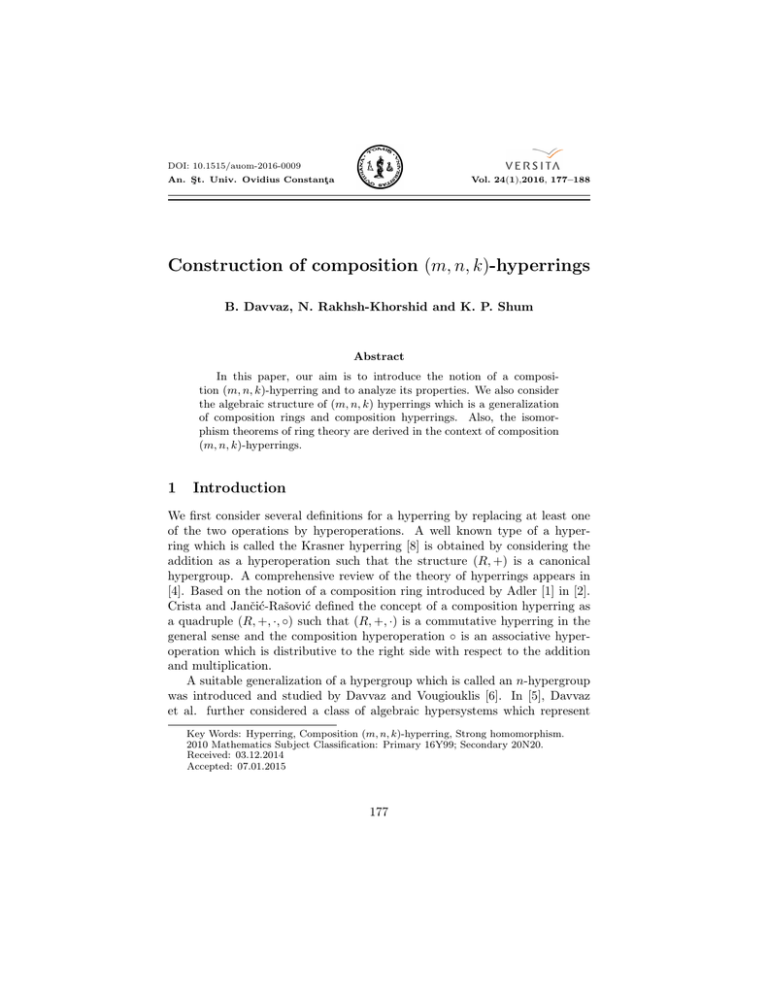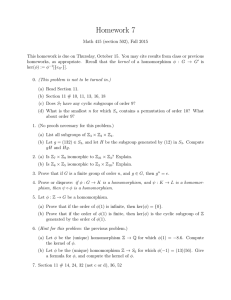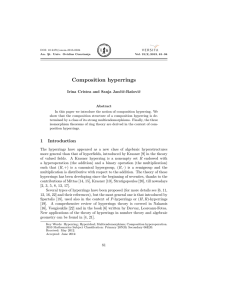Construction of composition (m, n, k)-hyperrings
advertisement

DOI: 10.1515/auom-2016-0009
An. Şt. Univ. Ovidius Constanţa
Vol. 24(1),2016, 177–188
Construction of composition (m, n, k)-hyperrings
B. Davvaz, N. Rakhsh-Khorshid and K. P. Shum
Abstract
In this paper, our aim is to introduce the notion of a composition (m, n, k)-hyperring and to analyze its properties. We also consider
the algebraic structure of (m, n, k) hyperrings which is a generalization
of composition rings and composition hyperrings. Also, the isomorphism theorems of ring theory are derived in the context of composition
(m, n, k)-hyperrings.
1
Introduction
We first consider several definitions for a hyperring by replacing at least one
of the two operations by hyperoperations. A well known type of a hyperring which is called the Krasner hyperring [8] is obtained by considering the
addition as a hyperoperation such that the structure (R, +) is a canonical
hypergroup. A comprehensive review of the theory of hyperrings appears in
[4]. Based on the notion of a composition ring introduced by Adler [1] in [2].
Crista and Jančić-Rašović defined the concept of a composition hyperring as
a quadruple (R, +, ·, ◦) such that (R, +, ·) is a commutative hyperring in the
general sense and the composition hyperoperation ◦ is an associative hyperoperation which is distributive to the right side with respect to the addition
and multiplication.
A suitable generalization of a hypergroup which is called an n-hypergroup
was introduced and studied by Davvaz and Vougiouklis [6]. In [5], Davvaz
et al. further considered a class of algebraic hypersystems which represent
Key Words: Hyperring, Composition (m, n, k)-hyperring, Strong homomorphism.
2010 Mathematics Subject Classification: Primary 16Y99; Secondary 20N20.
Received: 03.12.2014
Accepted: 07.01.2015
177
Construction Of Composition (m, n, k)-Hyperrings
178
a generalization of semigroups, hypersemiroups and n-semigroups. Then,
Leoreanu-Fotea in [9] continued to study the canonical n-hypergroups. Recently, the Krasner (m, n)-hyperrings are introduced and analyzed by Mirvakili and Davvaz [11]. Iin fact, the Krasner (m, n)-hyperrings are suitable
generalizations of the Krasner hyperrings. The notion of (m, n)-ary hyperring
in the general form was introduced in [3, 10], as the strong distributive structure. Then, in [7], Jančić-Rašović and Dašić further generalized such structure
by introducing the notion of (m, n)-hyperring with the inclusive distributivity.
In this paper, we introduce the notion of composition (m, n, k)-hyperring
as a generalization of the composition rings and composition hyperrings.
2
n-hypergroups and (m, n)-hyperrings
Let H be a non-empty set and f be a mapping from H n to P∗ (H), where
P∗ (H) is the family of all non-empty subsets of H. Then, f is called an
n-hyperoperation. If f is an n-hyperoperation defined on H, then (H, f ) is
called an n-hypergroupoid. If for all x1 , . . . , xn ∈ H the set f (x1 , . . . , xn )
is a singleton, then f is called an n-operation We now calll (H, f ) is called
an n-groupoid. The sequence xi , . . . , xj will be denoted by xji . For nonempty subsets A1 , . . . , An of H. Now, we define f (A1 , . . . , An ) = f (An1 ) =
∪{f (xn1 ) | xi ∈ Ai , i = 1, . . . , n}. The n-hyperoperation f is said to be asj−1
n+j−1
n+i−1
sociative if f (xi−1
), x2n−1
), x2n−1
1 , f (xi
n+i ) = f (x1 , f (xj
n+j ) holds for
2n−1
every i, j ∈ {1, . . . , n} and all x1
∈ H. An n-hypergroupoid with the associative hyperoperation is called an n-semihypergroup. An n-ary hypergroupoid
n
(H, f ) in which the equation b ∈ f (ai−1
1 , xi , ai+1 ) has a solution xi ∈ H for
i−1 n
every a1 , ai+1 , b ∈ H and 1 ≤ i ≤ n is called an n-quasihypergroup. An nsemihypergroup which is an n-quasihypergroup, is called an n-hypergroup. An
n-hypergroupoid (H, f ) is commutative if for all σ ∈ Sn and for every an1 ∈ H
we have f (a1 , . . . , an ) = f (aσ(1) , . . . , aσ(n) ). An element e of H is called an
(i−1)
(n−i)
identity element if x ∈ f ( e , x, e ) for all x ∈ H and all 1 ≤ i ≤ n. An
element 0 of an n-semihypergroup (H, f ) is called a zero element if for every
xn2 ∈ H we have f (0, xn2 ) = f (x2 , 0, xn3 ) = · · · = f (xn2 , 0) = 0. A commutative
n-hypergroup (H, f ) is called an n-canonical hypergroup if the following three
conditions are satisfied:
(1) there exists a unique e ∈ H such that for each x ∈ H, f (x, e(n−1) ) = x,
(2) for all x ∈ H there exists a unique x−1 ∈ H such that e ∈ f (x, x−1 , e(n−2) ),
(3) if x ∈ f (xn1 ), then for all 1 ≤ i ≤ n, we have
−1
−1
−1
xi ∈ f (x, x−1
1 , . . . , xi−1 , xi+1 , . . . , xn ).
Construction Of Composition (m, n, k)-Hyperrings
179
Now, we recall the definition of (m, n)-hyperring.
Definition 2.1. [10] An (m, n)-hyperring is a hyperstructure (R, f, g), which
satisfies the following axioms: (1) (R, f ) is an m-hypergroup, (2) (R, g) is
an n-semihypergroup, (3) the n-hyperoperation g is distributive with respect
to the m-hyperoperation f , i.e., for every a1i−1 , ani+1 , xm
1 ∈ R and 1 ≤ i ≤ n,
i−1
i−1
i−1
n
m
n
g(a1 , f (x1 ), ai+1 ) = f (g(a1 , x1 , ai+1 ), . . . , g(a1 , xm , ani+1 )). If the (m, n)hyperring R is commutative with respect to both m-hyperoperation f and
n-hyperoperation g, then it is called a commutative (m, n)-hyperring. A nonempty subset S ⊆ R is called an (m, n)-subhyperring of R if (S, f, g) is an
(m, n)-hyperring. An element 0 is called a zero element of (R, f, g) if it is an
m
m
identity of (R, f ) and for every xm
2 ∈ R, we have f (0, x2 ) = f (x2 , 0, x3 ) =
,
0)
=
0.
· · · = f (xm
2
Definition 2.2. [11] A Krasner (m, n)-hyperring is a hyperstructure (R, f, g)
which satisfies the following axioms: (1) (R, f ) is a canonical m-hypergroup,
(2)(R, g) is an n-semigroup,(3) the n-operation g is distributive with respect
n
m
to the m-hyperoperation f , i.e., for every ai−1
1 , ai+1 , x1 ∈ R and 1 ≤ i ≤ n,
we have
i−1
i−1
m
n
n
n
g(ai−1
1 , f (x1 ), ai+1 ) = f (g(a1 , x1 , ai+1 ), . . . , g(a1 , xm , ai+1 )),
(4) 0 is a zero element of the n-operation g, i.e., for every xn2 ∈ R we have
g(0, xn2 ) = g(x2 , 0, xn3 ) = · · · = g(xn2 , 0) = 0.
A non-empty subset I of a Krasner (m, n)-hyperring R is called an (m, n)hyperideal if (1) e ∈ I, (2) for every x ∈ I, −x ∈ I, (3) for every am
1 ∈ I,
i−1
n
n
f (am
)
⊆
I,
(4)
for
every
x
∈
R
and
1
≤
i
≤
n,
g(x
,
I,
x
)
⊆
I.
1
1
i+1
1
Lemma 2.3. [11] Let (R, f, g) be a Krasner (m, n)-hyperring. Then, the
following statements hold.
(1) For every x ∈ R, we have −(−x) = x and −0 = 0.
(m−2)
(2) For every x ∈ R, 0 ∈ f (x, −x,
0 ).
(3) For every xm
1 ∈ R, −f (x1 , . . . , xm ) = f (−x1 , . . . , −xm ), where −A =
{−a | a ∈ A}.
Let (R1 , f1 , g1 ) and (R2 , f2 , g2 ) be two (m, n)-hyperrings. Then, we define a homomorphism from R1 to R2 be a mapping φ : R1 → R2 such that
n
φ(f1 (am
1 )) = f2 (φ(a1 ), . . . , φ(am )) and φ(g1 (b1 )) = g2 (φ(b1 ), . . . , φ(bn )) hold,
m n
for all a1 , b1 ∈ R1 . The map φ is an isomorphism if it is one to one and onto
too. In this case, we say R1 is isomorphic to R2 and we denote R1 ∼
= R2 . The
kernel of φ is defined by ker(φ) = {(a, b) ∈ R1 × R1 | φ(a) = φ(b)}. If φ
is a homomorphism of Krasner (m, n)-hyperrings, then the kernel of φ is as
following ker(φ) = {x ∈ R1 | φ(x) = 0R2 }.
Construction Of Composition (m, n, k)-Hyperrings
3
180
Composition (m, n, k)-hyperrings
In this section, we present the notion of a composition (m, n, k)-hyperring
which is a generalization of the composition hyperring introduced by Crista
and Jančić-Rašović[2]. Some examples of this new hyperstructure are found
and will be expressed.
Definition 3.1. A composition (m, n, k)-hyperring is an algebraic composition
hyperstructure (R, f, g, h), where (R, f, g) is a commutative (m, n)-hyperring
and k-hyperoperation h (called composition) satisfies the following properties:
(1) h is the right distributive with respect to f ;
(2) h is the right distributive with respect to g,
(3) h is associative.
An element 0 of composition (m, n, k)-hyperring R is called a zero element
n
if it is a zero element of (m, n)-hyperring R and g(ai−1
1 , 0, ai+1 ) = 0, for every
i−1 n
a1 , ai+1 ∈ R and 1 ≤ i ≤ n. An element c ∈ R is called a constant if
i−1 k
k
h(ai−1
1 , c, ai+1 ) = c, holds for all a1 , ai+1 ∈ R and 1 ≤ i ≤ k. If A is an
arbitrary subset of R, then, the set of all constants in A is called a foundation
of A, denoted by F ound(A).
Example 1. Every composition hyperring is an composition (2, 2, 2)-hyperring.
One can see several examples of composition hyperrings in [2].
Example 2. Let (R, +, ·, ◦) be a composition hyperring. If we define f (xm
1 )=
x1 + . . . + xm , g(xn1 ) = x1 · . . . · xn and h(xk1 ) = x1 ◦ . . . ◦ xk . Then (R, f, g, h)
is a composition (m, n, k)-hyperring.
Example 3. Let (R, f, g) be a commutative (m, n)-hyperring. If we define
the k-hyperoperation h by h(xk1 ) = 0, for all xk1 ∈ R, then (R, f, g, h) is a
composition (m, n, k)-hyperring. In this case, we shall call R a null composition
(m, n, k)-hyperring.
Throughout the rest of the paper, (R, f, g, h) is always a composition
(m, n, k)-hyperring such that (R, f, g) be a Krasner (m, n)-hyperring.
Definition 3.2. Let R be a composition (m, n, k)-hyperring and N be a nonempty subset of R. Then, we call N a composition (m, n, k)-hyperideal of R if
the following conditions are satisfied:
(1) N is an (m, n)-hyperideal of Krasner (m, n)-hyperring R,
181
Construction Of Composition (m, n, k)-Hyperrings
k
k
(2) h(r1i−1 , n, ri+1
) ⊆ N , for all n ∈ N , r1i−1 , ri+1
∈ R and 1 ≤ i ≤ k,
(3) if f (r1i−1 , −rim ) ∩ N 6= ∅, then
j−1
j−1
k
k
k
f (h(tj−1
1 , r1 , tj+1 ), . . . , h(t1 , ri−1 , tj+1 ), h(t1 , −ri , tj+1 ),
j−1
. . . , h(t1 , −rm , tkj+1 ))
is a subset of N .
Let N be a composition (m, n, k)-hyperideal of R. Define on R the following
relation:
x N ∗ y ⇔ f (x, N,
(m−2)
(m−2)
0 ) = f (y, N,
0 ),
∗
for all x, y ∈ R. Clearly, N is an equivalence relation on R. Consider x ∈ R.
The equivalence class of x is defined by N ∗ [x] = {y ∈ R | y N ∗ x}. Then, we
(m−2)
have N ∗ [x] = f (x, N, 0 ). The set of all equivalence classes of the elements
of R with respect to the equivalence relation N ∗ is denoted by [R : N ] and it
defined as follows: [R : N ] = {N ∗ [x] | x ∈ R}.
Proposition 3.3. Let R be a composition (m, n, k)-hyperring and N be a
composition (m, n, k)-hyperideal of R. Then, we consider F , G and H as it
follows:
(m−2)
F (f (x1 , N,
(m−2)
G(f (x1 , N,
0 ), . . . , f (xn , N,
(m−2)
H(f (x1 , N,
(m−2)
0 ), . . . , f (xm , N,
0 ), . . . , f (xk , N,
(m−2)
0 )) = {f (z, N,
(m−2)
0 )) = {f (z, N,
(m−2)
0 )) = {f (z, N,
0 ) | z ∈ f (x1 , . . . , xm )},
(m−2)
0 ) | z ∈ g(x1 , . . . , xn )},
(m−2)
0 ) | z ∈ h(x1 , . . . , xk )}.
Then, the hyperoperations F , G and H are well defined.
Proof. The proof is is straightforward and is hence omited.
Theorem 3.4. ([R : N ], F, G, H) is a composition (m, n, k)-hyperring.
Proof. The proof is straightforward.
The above hyperstructure is called the quotient composition (m, n, k)-hyperring related to the equivalence relation N ∗ .
Definition 3.5. Let (R1 , f1 , g1 , h1 ) and (R2 , f2 , g2 , h2 ) be two composition
(m, n, k)-hyperrings. A mapping φ : R1 → R2 is called a strong homomorn k
phism if the following conditions are satisfied, for all xm
1 , y1 , z1 ∈ R1 :
(1) φ(f1 (x1 , . . . , xm )) = f2 (φ(x1 ), . . . , φ(xm )),
182
Construction Of Composition (m, n, k)-Hyperrings
(2) φ(g1 (y1 , . . . , yn )) = g2 (φ(y1 ), . . . , φ(yn )),
(3) φ(h1 (z1 , . . . , zk )) = h2 (φ(z1 ), . . . , φ(zk )),
(4) φ(0R1 ) = 0R2 .
A strong homomorphism φ is called an isomorphism if φ is one to one and
onto. We write R1 ∼
= R2 if R1 is isomorphic with R2 .
Proposition 3.6. If φ : R1 → R2 is a strong homomorphism, then for all
x ∈ R1 , it holds φ(−x) = −φ(x).
(m−2)
Proof. Since 0 ∈ f (x, −x,
conclude that
(m−2)
0 ), it follows that φ(0) ∈ φ(f (x, −x,
(m−2)
(m−2)
0
= φ(0) ∈ φ(f (x, −x,
0 )). We
0 )) = f (φ(x), φ(−x),
φ (0))
(m−2)
= f (φ(x), φ(−x),
0 )
(m−2)
Hence, 0 ∈ f (φ(x), φ(−x),
0 ) and so φ(−x) = −φ(x).
The kernel of φ is defined by ker(φ) = {x ∈ R1 | φ(x) = 0R2 }.
Proposition 3.7. Let φ : R1 → R2 be a strong homomorphism of(m, n)hyperrings. Then, ker(φ) is a hyperideal of R1 .
Proof. Set K := ker(φ). (1) φ(0) = 0. Thus, 0 ∈ K. (2) Let x ∈ K be an
arbitrary element. Then, φ(x) = 0 and by Proposition 3.6, we have φ(−x) =
−φ(x). It follows that φ(−x) = −0 = 0. So, −x ∈ K. (3) Suppose that
m
am
1 ∈ K. We have φ(a1 ) = φ(a2 ) = · · · = φ(am ) = 0. Consider x ∈ f (a1 ).
Then,
(m)
m
φ(x) ∈ φ(f (am
1 )) = f (φ(a1 ), . . . , φ(am )) = f ( 0 ) = 0 ⇒ x ∈ K ⇒ f (a1 ) ⊆ K.
i−1
n
n
(4) Let xi−1
1 , xi+1 ∈ R1 and 1 ≤ i ≤ n. Consider y ∈ g(x1 , K, xi+1 ). Then,
i−1
n
there exists k ∈ K such that y ∈ g(x1 , k, xi+1 ). Thus,
n
φ(y) ∈ φ(g(xi−1
1 , k, xi+1 )) = g(φ(x1 ), . . . , φ(xi−1 ), φ(k), φ(xi+1 ), . . . , φ(xn ))
= g(φ(x1 ), . . . , φ(xi−1 ), 0, φ(xi+1 ), . . . , φ(xn )) = 0.
n
It follows that y ∈ K and so g(xi−1
1 , k, xi+1 ) ⊆ K.
Notice that, in generally, ker(φ) is not a composition (m, n, k)-hyperideal.
In the following, we will state and prove the isomorphism theorems for
composition (m, n, k)-hyperrings.
183
Construction Of Composition (m, n, k)-Hyperrings
Theorem 3.8. Let (R1 , f, g, h) and (R2 , f, g, h) be two composition (m, n, k)hyperrings. If φ : R1 → R2 is a strong homomorphism with the kernel K such
that K is composition(m, n, k)-hyperideal of R1 , then [R1 : K] ∼
= Im(φ).
(m−2)
Proof. We define Ψ : [R1 : K] → Im(φ) by Ψ(f (x, K,
0 )) = φ(x), for all
(m−2)
x ∈ R1 . First, we prove that Ψ is well defined. Suppose that f (x, K,
(m−2)
f (y, K,
(m−2)
0 ). It is obvious that x ∈ f (x, K,
0
0 ). Thus, x ∈ f (y, K,
0
(m−2)
0
0 ). It follows that
(m−2)
0
⇒ φ(k ) ∈ φ(f (x, −y,
0 )
0 ).
(m−2)
Hence, there exists k ∈ K such that x ∈ f (y, k ,
k ∈ f (x, −y,
0 )=
(m−2)
0 ))
(m−2)
0
⇒ φ(k ) ∈ f (φ(x), φ(−y),
0 )
(m−2)
⇒ 0 ∈ f (φ(x), −φ(y),
⇒ φ(x) = φ(y).
0 )
Obviously, Ψ is onto. Now, we show that Ψ is one to one. Suppose that
φ(x) = φ(y). Then, we have
(m−2)
0 ∈ f (φ(x), −φ(y),
(m−2)
0 ) = φ(f (x, −y,
0 )).
(m−2)
Thus, there exists z ∈ f (x, −y,
fore,
0 ) such that φ(z) = 0. So, z ∈ K. There-
(m−2)
f (x, K,
(m−2)
0 ) ⊆ f (f (z, y,
(m−2)
f (y, K,
(m−2)
0 ) ⊆ f (f (x, z,
(m−2)
0 ) = f (y, K,
(m−2)
0 ), K,
(m−2)
It follows that f (x, K,
morphism, because
(m−2)
0 ), K,
0 ),
(m−2)
0 ) = f (x, K,
0 ).
(m−2)
0 ) = f (y, K,
0 ). Moreover, Ψ is a strong homo-
(m−2)
Ψ(F (f (x1 , K,
0 ), . . . , f (xm , K,
(m−2)
0 )))
(m−2)
0 ) | z ∈ f (x1 , . . . , xm )})
= Ψ({f (z, K,
(m−2)
= {Ψ(f (z, K, 0 )) | z ∈ f (x1 , . . . , xm )}
= {φ(z) | z ∈ f (x1 , . . . , xm )}
= φ(f (x1 , . . . , xm )) = f (φ(x1 ), . . . , φ(xm ))
(m−2)
= f (Ψ(f (x1 , K,
0 )), . . . , Ψ(f (xm , K,
(m−2)
0 ))),
184
Construction Of Composition (m, n, k)-Hyperrings
(m−2)
Ψ(G(f (x1 , K,
(m−2)
0 ), . . . , f (xn , K,
0 )))
(m−2)
0 ) | z ∈ g(x1 , . . . , xn )})
= Ψ({f (z, K,
(m−2)
= {Ψ(f (z, K, 0 )) | z ∈ g(x1 , . . . , xn )}
= {φ(z) | z ∈ g(x1 , . . . , xn )}
= φ(g(x1 , . . . , xn )) = g(φ(x1 ), . . . , φ(xn ))
(m−2)
= g(Ψ(f (x1 , K,
(m−2)
0 )), . . . , Ψ(f (xn , K,
(m−2)
Ψ(H(f (x1 , K,
0 ))),
(m−2)
0 ), . . . , f (xk , K,
0 )))
(m−2)
0 ) | z ∈ h(x1 , . . . , xk )})
= Ψ({f (z, K,
(m−2)
= {Ψ(f (z, K,
0 )) | z ∈ h(x1 , . . . , xk )}
= {φ(z) | z ∈ h(x1 , . . . , xk )}
= φ(h(x1 , . . . , xk )) = h(φ(x1 ), . . . , φ(xk ))
(m−2)
= h(Ψ(f (x1 , K,
(m−2)
0 )), . . . , Ψ(f (xk , K,
0 ))),
(m−2)
and Ψ(0[R1 :K] ) = Ψ(f (0, K, 0 )) = φ(0R1 ) = 0R2 . Hence, it is clear that Ψ
is isomorphism, i.e., [R1 : K] ∼
= Im(φ).
Theorem 3.9. If I1 , . . . , Im are composition (m, n, k)-hyperideals of a composition (m, n, k)-hyperring R and 1 ≤ j ≤ m, then
m
m
[f (I1J−1 , 0, Ij+1
) : f (I1J−1 , 0, Ij+1
) ∩ Ij ] ∼
= [f (I1m ) : Ij ].
Proof. For all 1 ≤ j ≤ m, Ij is a composition (m, n, k)-hyperideal of f (I1m )
m
and so [f (I1m ) : Ij ] is defined. Let us take Ψ : f (I1j−1 , 0, Ij+1
) → [f (I1m ) : Ij ]
(m−2)
by Ψ(a) = f (a, Ij , 0 ). It is easy to verify that Ψ is well-defined. We prove
that Ψ is a strong homomorphism.
S
Ψ(f (a1 , . . . , am )) =
Ψ(v)
v∈f (am
1 )
(m−2)
=
S
f (v, Ij ,
0 )
v∈f (am
1 )
(m−2)
= f (f (a1 , . . . , am ), Ij ,
0 )
(m−2)
= f (f (a1 , Ij , 0 ), . . . , f (am , Ij ,
= f (Ψ(a1 ), . . . , Ψ(am )),
(m−2)
0 ))
185
Construction Of Composition (m, n, k)-Hyperrings
Ψ(g(a1 , . . . , an ))
S
=
Ψ(v)
v∈g(an
1)
(m−2)
S
=
f (v, Ij ,
(m−2)
0 ) = f (g(a1 , . . . , an ), Ij ,
0 )
v∈g(an
1)
(m−2)
(m−2)
= g(f (a1 , Ij , 0 ), . . . , f (an , Ij ,
= g(Ψ(a1 ), . . . , Ψ(an )),
S
Ψ(h(a1 , . . . , ak )) =
Ψ(v)
0 ))
v∈h(ak
1)
(m−2)
=
S
f (v, Ij ,
0 )
v∈h(ak
1)
(m−2)
= f (h(a1 , . . . , ak ), Ij ,
0 )
(m−2)
(m−2)
= h(f (a1 , Ij , 0 ), . . . , f (ak , Ij ,
= h(Ψ(a1 ), . . . , Ψ(ak )),
0 ))
(m−2)
Ψ(0f (I j−1 ,0,I m ) )
1
j+1
= f (0f (I j−1 ,0,I m ) , Ij ,
1
0 )
j+1
(m−2)
m
= f (f ( 0 ), Ij ,
0 ) = Ij = 0[f (I1m ):Ij ] .
Obviously, Ψ is onto. Suppose that a ∈ ker(Ψ). Hence, we have
(m−2)
a ∈ Ker(Ψ) ⇔ Ψ(a) = Ij ⇔ f (a, Ij ,
m
0 ) = Ij ⇔ a ∈ Ij ∩ f (I1j−1 , 0, Ij+1
).
by Theorem 3.8, we get the isomorphism
m
m
[f (I1J−1 , 0, Ij+1
) : f (I1J−1 , 0, Ij+1
) ∩ Ij ] ∼
= [f (I1m ) : Ij ]
Theorem 3.10. If A and B are composition (m, n, k)-hyperideals of R such
that A ⊆ B, then [B : A] is a composition (m, n, k)-hyperideal of [R : A] and
[[R : A] : [B : A]] ∼
= [R : B].
Proof. First, we prove that [B : A] is a composition (m, n, k)-hyperideal of
(m−2)
[R : A]. We define φ : [R : A] → [R : B] by φ(f (r, A,
0 )) = f (r, B,
(m−2)
0 ).
186
Construction Of Composition (m, n, k)-Hyperrings
Obviously, φ is well-defined. Moreover, φ is a strong homomorphism, because
(m−2)
φ(F (f (r1 , A,
(m−2)
0 ), . . . , f (rm , A,
0 )))
(m−2)
0 ) | z ∈ f (r1 , . . . , rm )})
= φ({f (z, A,
(m−2)
= {φ(f (z, A,
0 )) | z ∈ f (r1 , . . . , rm )}
(m−2)
= {f (z, B,
0 ) | z ∈ f (r1 , . . . , rm )}
(m−2)
= F (f (r1 , B,
(m−2)
0 ), . . . , f (rm , B,
0 ))
(m−2)
= F (φ(f (r1 , A,
(m−2)
φ(G(f (r1 , A,
(m−2)
0 )), . . . , φ(f (rm , A,
0 ))),
(m−2)
0 ), . . . , f (rn , A,
0 )))
(m−2)
0 ) | z ∈ g(r1 , . . . , rn )})
= φ({f (z, A,
(m−2)
= {φ(f (z, A,
0 )) | z ∈ g(r1 , . . . , rn )}
(m−2)
= {f (z, B,
0 ) | z ∈ g(r1 , . . . , rn )}
(m−2)
= G(f (r1 , B,
(m−2)
0 ), . . . , f (rn , B,
0 ))
(m−2)
= G(φ(f (r1 , A,
(m−2)
φ(H(f (r1 , A,
(m−2)
0 )), . . . , φ(f (rn , A,
0 ))),
(m−2)
0 ), . . . , f (rk , A,
0 )))
(m−2)
0 ) | z ∈ h(r1 , . . . , rk )})
= φ({f (z, A,
(m−2)
= {φ(f (z, A,
0 )) | z ∈ h(r1 , . . . , rk )}
(m−2)
= {f (z, B,
0 ) | z ∈ h(r1 , . . . , rk )}
(m−2)
= H(f (r1 , B,
0 ), . . . , f (rn , B,
(m−2)
0 ))
(m−2)
= H(φ(f (r1 , A,
0 )), . . . , φ(f (rk , A,
(m−2)
0 ))).
187
Construction Of Composition (m, n, k)-Hyperrings
(m−2)
ker(φ) = {f (r, A,
(m−2)
= {f (r, A,
(m−2)
0 ) ∈ [R : A] | φ(f (r, A,
0 ) ∈ [R : A] | f (r, B,
0 )) = 0[R:B] }
(m−2)
0 ) = B}
(m−2)
= {f (r, A,
0 ) ∈ [R : A] | r ∈ B} = [B : A].
by Theorem 3.8, we conclude that [[R : A] : [B : A]] ∼
= [R : B].
References
[1] I. Adler, Composition rings, Duke Math. J., 29 (1962), 607–623.
[2] I. Cristea and S. Jančić-Rašović, Composition hyperrings, An. Şt. Univ.
Ovidius Constanţa, 21(2) (2013), 81–94.
[3] B. Davvaz, A new view of fundamental relations on hyperrings, Proceedings of 10th Int. Congress on Algebraic Hyperstructures and Applications,
AHA 2008, pp. 43-55.
[4] B. Davvaz and V. Leoreanu-Fotea, Hyperring Theory and Applications,
International Academic Press, USA, 2007.
[5] B. Davvaz, W.A. Dudek and T. Vougiouklis, A generalization of n-ary
algebraic systems, Comm. Algebra, 37(4) (2009), 1248–1263.
[6] B. Davvaz and T. Vougiouklis, n-ary hypergroups, Iran. J. Sci. Technol.
Trans. A, 30(2) (2006), 165–174.
[7] S. Jančić-Rašović and V. Dašić, Some new classes of (m, n)-hyperrings,
Faculty of Sciences and Mathematics, University of Nis, Serbia, 26(3)
(2012), 585–596.
[8] M. Krasner, A class of hyperrings and hyperfields, International Journal
of Mathematics and Mathematical Sciences, 2 (1983), 307-312.
[9] V. Leoreanu-Fotea, Canonical n-ary hypergroups, Italian. J. Pure Appl.
Math., 24 (2008).
[10] S. Mirvakili and B. Davvaz, Constructions of (m, n)-hyperrings, Matematicki Vesnik, 67(1) (2015), 1-16.
[11] S. Mirvakili and B. Davvaz, Relations on Krasner (m, n)-hyperrings, Euoropean. J. Combin., 31 (2010), 790–802.
Construction Of Composition (m, n, k)-Hyperrings
B. DAVVAZ,
Department of Mathematics,
Yazd University,
Yazd, Iran.
Email: davvaz@yazd.ac.ir, bdavvaz@yahoo.com
N. RAKHSH-KHORSHID,
Department of Mathematics,
Yazd University,
Yazd, Iran.
E-mail: rakhshkhorshid@stu.yazd.ac.ir
K. P. SHUM,
Institute of Mathematics,
Yunnan University
Kunming, 650091, PR. China
E-mail: kpshum@ynu.edu.cn
188







